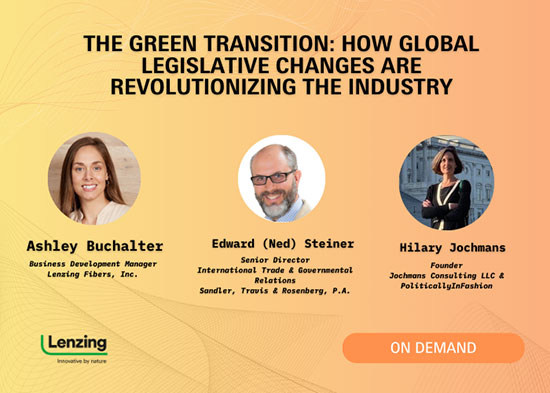June 13, 2024

Regulation is coming for the apparel industry. Fast. With more than a dozen pieces of legislation on the docket in the U.S. and EU, it’s hard to focus on the details of each policy, let alone set a course for compliance. But even among all of this policy activity, one thing is clear: transparency and traceability are at the center of the efforts for pushing fashion to accelerate change.
A key pillar of the Ecodesign Sustainable Product Regulation (ESPR) policy, digital product passports (DPPs) are designed to pull back the curtain on each product’s entire lifecycle, giving stakeholders insight into its raw materials, resource usage and longevity. And unlike some other regulations (think: CSDDD, which only applies to entities of a certain size and revenue), DPPs would be required for all products.
“The reason why government bodies want to access that data is to make sure that the product on the market lives up to a certain ecodesign framework. That would mean that as a designer you would need to have the end in mind during the design stage,” said Nina Shariati, founder of the Circular Transparency consultancy and former sustainability strategist at H&M Group, adding that means that when shopping a textile show, it’s no longer just about concerns like aesthetics and hand feel but also about characteristics like durability and recyclability. “For that, you need education, you need tools and you need access to materials that have the right content.”
To that point, Shariati said that even though there are still a lot of unknowns with DPPs, product developers, designers and everyone along the supply chain should make sure they’re up to speed on what it means to design products for circularity. Ideally, she said, companies will support employees as they attempt to upskill in this area.
The Data Deluge
Ultimately, to comply, each partner along the supply chain will need to amass verifiable data on every aspect of their products and processes. It’s a heavy lift that production companies and suppliers are already gearing up for. While some are trialing their own versions of DPPs, others are in the education phase, both internally and with their suppliers further up the chain. For some, it has already proven costly in terms of manhours as well as technology.
“The readiness is on so many different levels,” Shariati said. “I'm not sure everyone has fully grasped the different decision layers that are needed—strategic but also operational, and from process and tech.”
While the undertaking seems enormous, Katie Weir, fashion & luxury co-lead for advisory firm Deloitte, said the timing actually is perfect.
“The confluence of this regulation and AI couldn't be better. Let's harness AI as much as we can within this process,” she said, adding companies need to make sure they have the technology in place to handle the “significant” data load now. “We are encouraging all of our clients, regardless of where they are in the value chain, to make sure that you have that digital backbone shored up so that then you can layer on whatever solutions you will need for compliance.”
Norwegian brand Kappahl participated in a DPP pilot for textile products led by traceability platform TrusTrace. The company, along with Marimekko of Finland, shared some high-level observations about its experiences in TrusTrace’s Unlocking DPP report. For instance, Sandra Roos, vice president of sustainability for Kappahl, found that the data and its format needs to be standardized at the consumer level to give shoppers the ability to compare apples to apples. Kappahl also reported that the pilot called for more manpower than had been initially projected, particularly across IT, merchandising and quality. The biggest question mark, Roos said, is what data will be deemed legal to use when it comes to calculating a product’s climate footprint—and whether those calculation methodologies will dovetail with other local or national ESG-related regulations.
With various local, regional and national governments racing to enact policies at once, Weir said more collaboration will be needed between these entities to reduce compliance headaches and to help these policies foster their intended goals. It’s a missing piece of the puzzle even as she’s seeing the individual players within the industry pull together. “Collaboration will be absolutely key for this, and that's what we're actually seeing in the industry,” she said. By example, she points to the Aura Blockchain Consortium, which is a nonprofit made up of more than 40 luxury brands designed to collaborate on transparency and traceability solutions. (You can learn more about DPPs in the luxury space in Deloitte’s digital product passport report here.)
The Long-Term Upside
If compliance sounds overwhelming, Weir said the good news is ESPR, in general, and DPPs, in particular, will benefit the industry. “Compliance is huge, and that's what this is all about, but the value that can be created in addition should not be underestimated,” she said.
In working with clients on case studies, Deloitte has identified a few key benefits. The first is building customer loyalty by linking brands to not just the end consumer but the resale consumer for the life of the product. This opens up marketing opportunities for related items as well as experiential offerings similar to what companies have tried through NFTs. It’s a relationship builder as well as a new revenue pipeline.
The information amassed for DPPs could also change the face of retail. “[DPPs are] bringing the suppliers to the very forefront of the customer journey. A lot of marketing teams are thinking through what we can do from an in-store experience with some of this information,” Weir said.
That benefit is particularly possible with luxury shoppers who are more likely to be clued into the heritage of a brand and the provenance of its products. It remains to be seen the degree to which everyday consumers will access the information in DPPs and if that will impact their buying decisions.
Beyond the consumer experience, Weir sees DPPs as an avenue toward building better businesses. “Data unlocks value,” she explained. “Obviously, the goal of this is to eliminate waste. And waste elimination helps everyone's bottom line. So that is a benefit to consumers as well as to everyone within the value chain.”
Shariati said DPPs will go a long way toward moving the industry toward a circular economy. “The focus of DPPs should be [to use this] wealth of data to see how to make sure resellers get access to the information they need so they can transparently communicate to their customers. Also, to see how sorters can get access to the information so that they can become more efficient in their sorting,” she said. “In terms of creating that efficiency and circular supply chain operations, that is where I see DPPs creating the most value and the most impact.”

Texworld Welcomes the ITPC Vietnam Pavilion
Texworld and Apparel Sourcing will feature more than 20 exhibitors from Vietnam participating in the Investment & Trade Promotion Centre of Ho Chi Minh City Vietnam (ITPC) Pavilion.
Quick facts about Vietnam from World Fashion Exchange:
- Vietnam is the third largest textile and garment-producing country in the world, offering a diversified range of products
- The country boasts the capability to produce 10.5 billion meters of fabric and 5 billion garments annually
- The U.S. imports almost 50 percent of the country’s textile and apparel exports
- Vietnam is a knitwear powerhouse with woven apparel, footwear and bags as additional key categories
- Vietnam has set targets to reduce textile and apparel industry energy consumption by 15 percent and water consumption by 20 percent
The ITPC Vietnam Pavilion is just one of several special interest areas within the show, including EPB Bangladesh, Lenzing, KTTA Korea, TTF Taiwan and TDAP Pakistan. Make plans to join us July 16-18, which will truly represent the global nature of the apparel supply chain.

Visit Texworld’s Next-Gen Innovation Hub
Next-Gen textiles are at the forefront of innovation and sustainability and will be a key pillar as the industry looks for ways to be less impactful. To help buyers discover the latest in material innovation, Texworld NYC will feature companies showcasing responsible fibers and fabrics in its Next-Gen Innovation Hub. Plan to shop the hub to find raw materials that will enable your organization to become more eco-friendly, position itself to participate in the circular economy and take further steps toward responsible manufacturing. The Next-Gen Innovation Hub is the latest way Messe Frankfurt is promoting econogy, the company’s term for demonstrating that doing good for the planet is also a boon for business.

Lenzing Seminar Series: What You Can Do About Pending ESG Policy
Texworld’s “Green Transition: How Global Legislative Changes are Revolutionizing the Industry” panel is now available on demand.
The discussion, led by moderator Ashley Buchalter, business development manager for Lenzing Fibers, reveals how the slate of potential new ESG-related policies in the U.S. and EU will impact how and where clothes are made and marketed. Panelists Ned Steiner, senior director of international trade and governmental relations at Sandler, Travis & Rosenberg, and Hilary Jochmans, founder of Jochmans Consulting LLC and the public policy community PoliticallyInFashion, break down what you need to know as these policies go from theoretical to reality.
“2024 is an election year, not only here, but in many countries throughout the world, and that's going to be very impactful on public policy and legislation,” Jochmans said, adding that alone could push some policies forward as legislatures attempt to gain momentum ahead of any presidential or congressional changes. “There's a real impetus to get things done. You’ve got to have some sort of deliverables.”
The pace at which some of these regulations could be written means it’s not enough to just be aware of what’s being proposed, Steiner said.
“I would just encourage people to be active and vocal about that with your representatives, both on the state level but also on the federal level… because there's a lot going on in Washington, and in all likelihood, it will affect your business and the way you do business,” he said.
Jochmans agreed, stating, “If you write something that you can't possibly implement, then that's almost worse than nothing.”
Listen to the full panel here to learn more about the FTC’s GreenGuides, the potential for any of this legislation to include incentives, and why it’s imperative to actively engage with state legislatures, in particular.

What We’re Reading
Why It’s So Hard to Track the Fashion Industry’s Emissions
Most can agree fashion’s movement toward cutting GHG emissions is too slow–but pinpointing the progress (or lack thereof) is proving almost impossible in some cases due to a reporting “mess,” according to Bloomberg. The news outlet studied the emissions of 38 apparel companies and found that less than half could even be assessed because they either didn’t have the necessary data or had information that wasn’t detailed enough. Of the companies that met its qualifications, only 11 had emissions reductions—and nine saw emissions increase. Read the article to learn what it will take for the industry to be able to conduct true “apples to apples” comparisons and how legislation could help.
The Global Fashion Summit 2024: Lofty goals but limited progress
Last month’s Global Fashion Summit convened climate activists and apparel executives from around the globe for its annual conference. In its assessment of the event and its impact over the last 15 years, Glossy highlights a “gap between aspiration and action” that can’t be ignored. The publication highlighted the persistent wage gaps, the compliance challenges inherent in pending legislation and the general inability to decouple growth from environmental impacts. Read the article to learn about new initiatives like the Trailblazer Programme for early-stage innovators and the Next Gen Assembly 2024 for young professionals.
Are microfactories the answer to making fashion on demand?
Is the current apparel supply chain with its massive factories located thousands of miles from the end consumer untenable? Vogue Business explores the opportunities and limitations of small factories designed to create products on demand. Through automation, the publication found, microfactories like the Danish company Rodinia make small runs fast, efficient and cost effective, though material selection is limited, restricting what brands can produce. Read the article to see how factories like Rodinia are working to address their challenges, including creating “mirco-supply chains.”